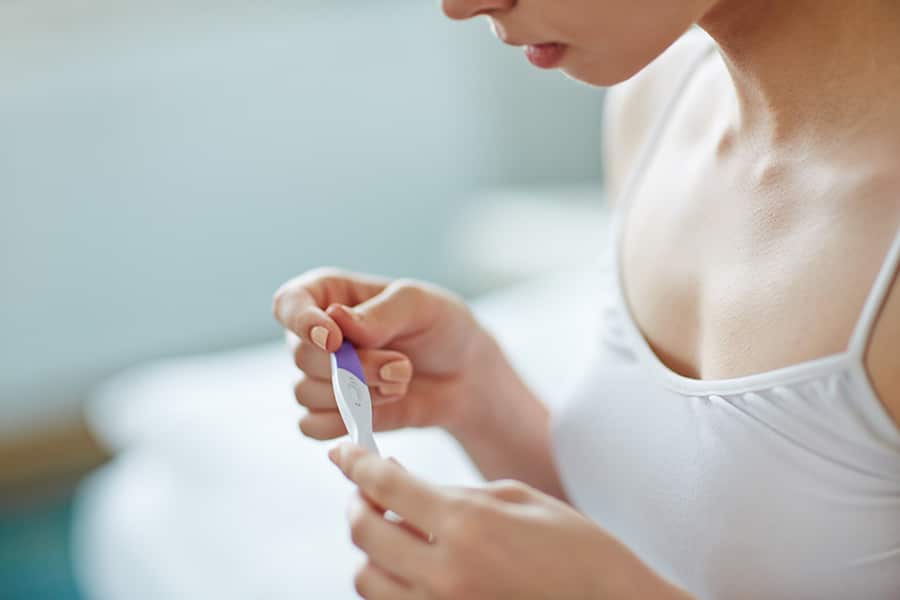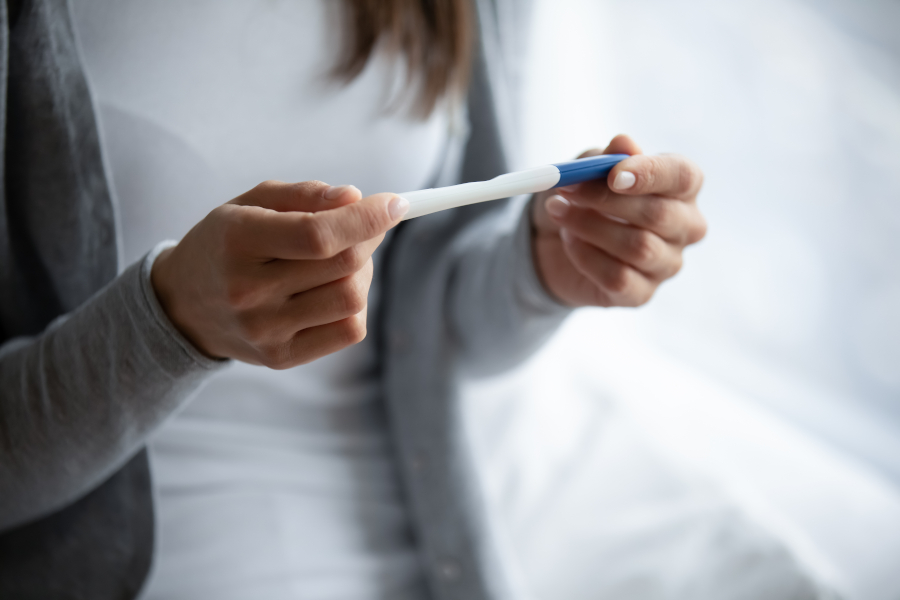
Reliable home pregnancy tests were first introduced in 1976. Over the years they have become the most common diagnostic assay that is used in homes. The tests utilize monoclonal or polyclonal antibodies to detect the presence of human chorionic gonadotropin (hCG) in the urine samples tested. Human chorionic gonadotropin is a hormone produced very early in pregnancy and the levels rise quickly throughout the pregnancy and are easily detected. It is important to be careful of claims made in the package insert/instructions because research has shown that some of these claims are unfounded. When using a home pregnancy test it is very important to read all the instructions carefully and follow them closely to get the best results. Home pregnancy tests are available without a prescription and can be found in drug stores, pharmacies, grocery stores, and some convenience stores.

Efforts to detect an early pregnancy in women have been made for over thousands of years. There are records showing that claims to detect early pregnancy occurred in ancient times. In ancient Egypt a primitive pregnancy tests consisted of having a woman urinate on barley and wheat seeds. If the barley seed sprouted and grew it meant she was pregnant with a boy. If the wheat seed sprouted it meant she was pregnant with a girl. If no growth, no pregnancy.
Over the years a variety of tests were developed with a variety of results. By the early 20th century scientists discovered the existence of human chorionic gonadotropin (hCG) hormone in the blood and eventually determined that women produced hCG after the egg was fertilized and implanted in the uterine wall. It was later discovered that hCG was present and detectable in urine. The very first bioassay for hCG was introduced in 1927, the Aschheim-Zondek Test (the A – Z Test). In this test the woman’s urine was injected into an immature rat or mouse. If the animal went into an estrous state, went into heat, it implied the presence of hCG in the urine and a positive pregnancy. In the 1930s in addition to rats and mice, rabbits, frogs, and toads were used to determine a human pregnancy. The animal was injected with the subject’s urine, the animal would later be sacrificed to see if ovulation occurred. The ovulation had occurred it was determined that hCG was present in the urine sample and the woman was pregnant. The tests were expensive, time consuming, not always accurate, and an innocent animal lost its life. The phrase “the Rabbit died” was widely used to indicate that a woman’s urine pregnancy test was positive. In the late 1970s the Food and Drug Administration approved pregnancy test kits for home use.
The hormone hCG is produced very early in pregnancy by trophoblast cells. After implantation in the uterine wall the placenta produces increasing amounts of hCG throughout pregnancy. hCG is the marker for pregnancy in both laboratory and home pregnancy tests. Eight days after conception hCG can be detected in the maternal circulation and a few days after that in maternal urine. Today home pregnancy tests, often called home pregnancy test sticks or pregnancy sticks, are readily available, inexpensive, and easy to use. They use monoclonal or polyclonal antibodies to bind hCG and produce a reaction which results in a color change. This typically results in a visible marker line.

Many home pregnancy test sticks claim to be more than 99% accurate when used from the day of expected pregnancy. Those figures are determined based on laboratory testing of urine samples carried out by trained laboratory technicians under ideal conditions. In the real world the sensitivity of home pregnancy tests declined when real subjects performed the test on their own urine at home, not in a laboratory. The reason for this was determined to be the difficulty women had in understanding the product instructions. This difficulty occurred regardless of the subject’s socio-economic group.
The most common home pregnancy test is the midstream stick or pregnancy stick. Midstream test sticks typically consist of a stick with an absorbent wick at the end. The wick is placed in the urine stream or dipped into a container of collected urine.
Keep these things in mind when considering using a home pregnancy test.

If I get a positive result on a home pregnancy test, does that mean I am pregnant?
A positive result from a home pregnancy test shows the presence of the hormone hCG in your system. When an egg is implanted in a woman’s uterine wall, hCG is produced and continues to be produced throughout the pregnancy. This is a sign that you have become pregnant. Under normal circumstances only the placenta produces hCG.
If I get a negative result on a home pregnancy test, does that mean I am not pregnant?
A negative result can mean that you are not pregnant, you took the test too early, or you took the test wrong. Pregnancy tests vary in their sensitivity (how soon they can detect the hormone hCG), and you may not have given your body enough time to produce enough hCG that will be detected on a home pregnancy test. Also, if you let a test sit for too long (longer than the instructions on the box tell you), the test is invalid. It is best to follow the instructions carefully and wait until you have missed a period before taking the test. Most pregnancy tests come with two sticks in a box, it is a good idea to repeat a negative test.

When is the earliest I can take a home pregnancy test? It is recommended that you wait until you have missed a period to take a home test. A missed period is often one of the first signs of pregnancy. If you cannot wait that long to find out and you know the day you may have conceived, then the earliest you can take a test would be 14 days from possible conception.
What if I take a couple of home pregnancy tests and get different answers? If you have received different results on multiple pregnancy tests, it is recommended that you get a blood test performed in a medical facility to get an accurate answer.
What should I do after getting a positive pregnancy test?
If you take a pregnancy test at home and it’s positive, there are a few things you should do, including:
The widespread use of home pregnancy tests has been a tremendous game changer for women of all socio-economic groups to help them make very personal and intimate decisions regarding family planning. Home pregnancy stick tests are not infallible, but they do provide very important information for a very small financial commitment.
The information is presented to be a general guide to present information about home pregnancy tests. It is for informational purposes only. The information provided is not intended to be the only information available concerning pregnancy tests to be used at home. The material provided is not expected to be a substitute for advice or information from your physician or health care provider.
If you have any questions, concerns, apprehensions, unease, or worry about home pregnancy stick tests contact your health care provider immediately.


ALL WARRANTIES OF ANY KIND WHATSOEVER EXPRESS, IMPLIED, AND STATUTORY, ARE HEREBY DISCLAIMED. ALL IMPLIED WARRANTIES OF MERCHANTABILITY AND FITNESS FOR A PARTICULAR PURPOSE ARE HEREBY DISCLAIMED. THE PRODUCTS SOLD, INCLUDING SONOGRAMS, ULTRASOUNDS, FAKE PREGNANCY DOCUMENTS, AND FAKE PREGNANCY TESTS ARE SOLD ‘AS IS’ BASIS.
THE SITE CANNOT AND DOES NOT CONTAIN [MEDICAL/ LEGAL/ FITNESS/ HEALTH/ OTHER] ADVICE. THE INFORMATION IS PROVIDED FOR PRANKS PURPOSES ONLY AND IS NOT A SUBSTITUTE FOR PROFESSIONAL ADVICE.
ACCORDINGLY, BEFORE TAKING ANY ACTIONS BASED UPON SUCH INFORMATION, WE ENCOURAGE YOU TO CONSULT WITH THE APPROPRIATE PROFESSIONALS. WE DO NOT PROVIDE ANY KIND OF MEDICAL/ LEGAL/ FITNESS/ HEALTH ADVICE. THE USE OR RELIANCE OF ANY INFORMATION CONTAINED ON THIS SITE, OR OUR MOBILE APPLICATION, IS SOLELY AT YOUR OWN RISK.
THIS WEBSITE DOES NOT PROVIDE MEDICAL ADVICE. THE INFORMATION, INCLUDING BUT NOT LIMITED TO, TEXT, GRAPHICS, IMAGES AND OTHER MATERIAL CONTAINED ON THIS WEBSITE ARE FOR PRANK PURPOSES ONLY. NO MATERIAL ON THIS SITE IS INTENDED TO BE A SUBSTITUTE FOR PROFESSIONAL MEDICAL ADVICE, DIAGNOSIS OR TREATMENT. ALWAYS SEEK THE ADVICE OF YOUR PHYSICIAN OR OTHER QUALIFIED HEALTH CARE PROVIDER WITH ANY QUESTIONS YOU MAY HAVE REGARDING A MEDICAL CONDITION OR TREATMENT AND BEFORE UNDERTAKING NEW HEALTH CARE REGIMEN, AND NEVER DISREGARD PROFESSIONAL MEDICAL ADVICE OR DELAY IN SEEKING IT BECAUSE OF SOMETHING YOU HAVE READ ON THIS WEBSITE.
THE PARTIES AGREE THAT ANY PRODUCT PURCHASED ON THE BABY MAYBE WEBSITE SHALL NOT BE USED FOR ANY PROPOSE OTHER THAN AS A PRANK. WITHOUT EXCEPTION NO BABY MAYBE PRODUCT SHALL BE PROVIDED/SUBMITTED TO ANY GOVERNMENTAL OR OTHER AGENCY, MEDICAL DOCTOR, ARBITER OF A DISPUTE, AS PROOF OF PREGNANCY, PAST OR CURRENT, OR TO CLAIM ANY BENEFIT FOR WHICH A PREGNANT WOMAN MAY BE ELIGIBLE, OR ENTITLED TO RECEIVE, BASED ON HER BEING PREGNANT. NO HIPAA PROTECTED PATIENT HEALTH INFORMATION CONNECTED TO ANY BABY MAYBE PRODUCT, IS INTENDED, OR CONVEYED, WITH RESPECT TO THIS SALE.
THE PARTIES AGREE THAT BABYMAYBE IS NOT RESPONSIBLE FOR ANY LIABILITY WHATSOEVER FOR DELAYS IN SHIPPING THE PRODUCT. THE PARTIES FURTHER AGREE THAT THE SOLE REMEDY FOR ANY SHIPPING DELAYS IS THE REFUND OF THE PURCHASER’S PAYMENT FOR THE PRODUCT.
THE PARTIES AGREE THAT THE FORUM FOR ANY LEGAL ACTION ASSOCIATED WITH THE SALE AND PURCHASE OF THE PRODUCT IS THE STATE OF ILLINOIS.